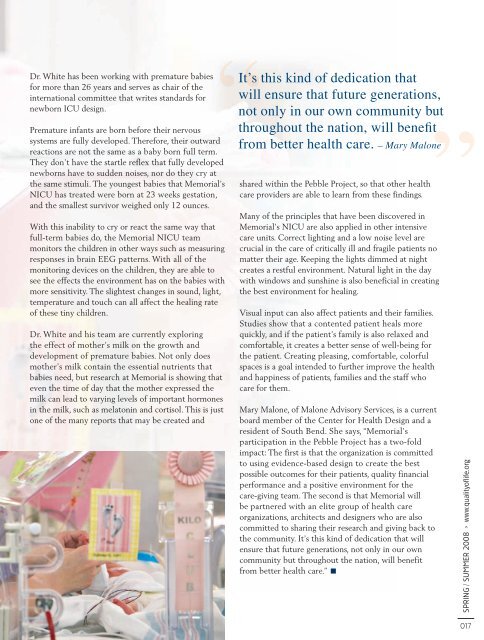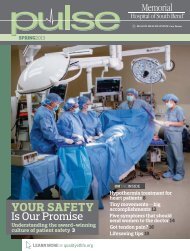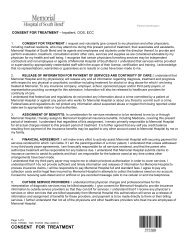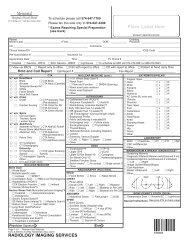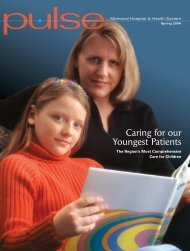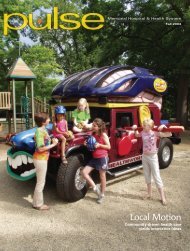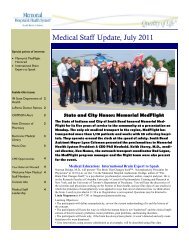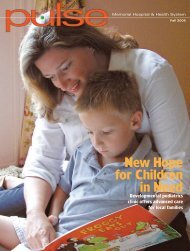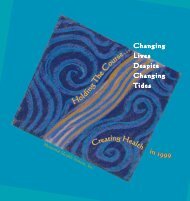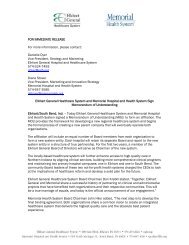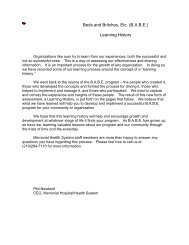Spring 2008 - Memorial Hospital of South Bend
Spring 2008 - Memorial Hospital of South Bend
Spring 2008 - Memorial Hospital of South Bend
Create successful ePaper yourself
Turn your PDF publications into a flip-book with our unique Google optimized e-Paper software.
Dr. White has been working with premature babies<br />
for more than 26 years and serves as chair <strong>of</strong> the<br />
international committee that writes standards for<br />
newborn ICU design.<br />
Premature infants are born before their nervous<br />
systems are fully developed. Therefore, their outward<br />
reactions are not the same as a baby born full term.<br />
They don’t have the startle reflex that fully developed<br />
newborns have to sudden noises, nor do they cry at<br />
the same stimuli. The youngest babies that <strong>Memorial</strong>’s<br />
NICU has treated were born at 23 weeks gestation,<br />
and the smallest survivor weighed only 12 ounces.<br />
With this inability to cry or react the same way that<br />
full-term babies do, the <strong>Memorial</strong> NICU team<br />
monitors the children in other ways such as measuring<br />
responses in brain EEG patterns. With all <strong>of</strong> the<br />
monitoring devices on the children, they are able to<br />
see the effects the environment has on the babies with<br />
more sensitivity. The slightest changes in sound, light,<br />
temperature and touch can all affect the healing rate<br />
<strong>of</strong> these tiny children.<br />
Dr. White and his team are currently exploring<br />
the effect <strong>of</strong> mother’s milk on the growth and<br />
development <strong>of</strong> premature babies. Not only does<br />
mother’s milk contain the essential nutrients that<br />
babies need, but research at <strong>Memorial</strong> is showing that<br />
even the time <strong>of</strong> day that the mother expressed the<br />
milk can lead to varying levels <strong>of</strong> important hormones<br />
in the milk, such as melatonin and cortisol. This is just<br />
one <strong>of</strong> the many reports that may be created and<br />
It’s this kind <strong>of</strong> dedication that<br />
will ensure that future generations,<br />
not only in our own community but<br />
throughout the nation, will benefit<br />
from better health care. – Mary Malone<br />
shared within the Pebble Project, so that other health<br />
care providers are able to learn from these findings.<br />
Many <strong>of</strong> the principles that have been discovered in<br />
<strong>Memorial</strong>’s NICU are also applied in other intensive<br />
care units. Correct lighting and a low noise level are<br />
crucial in the care <strong>of</strong> critically ill and fragile patients no<br />
matter their age. Keeping the lights dimmed at night<br />
creates a restful environment. Natural light in the day<br />
with windows and sunshine is also beneficial in creating<br />
the best environment for healing.<br />
Visual input can also affect patients and their families.<br />
Studies show that a contented patient heals more<br />
quickly, and if the patient’s family is also relaxed and<br />
comfortable, it creates a better sense <strong>of</strong> well-being for<br />
the patient. Creating pleasing, comfortable, colorful<br />
spaces is a goal intended to further improve the health<br />
and happiness <strong>of</strong> patients, families and the staff who<br />
care for them.<br />
Mary Malone, <strong>of</strong> Malone Advisory Services, is a current<br />
board member <strong>of</strong> the Center for Health Design and a<br />
resident <strong>of</strong> <strong>South</strong> <strong>Bend</strong>. She says, “<strong>Memorial</strong>’s<br />
participation in the Pebble Project has a two-fold<br />
impact: The first is that the organization is committed<br />
to using evidence-based design to create the best<br />
possible outcomes for their patients, quality financial<br />
performance and a positive environment for the<br />
care-giving team. The second is that <strong>Memorial</strong> will<br />
be partnered with an elite group <strong>of</strong> health care<br />
organizations, architects and designers who are also<br />
committed to sharing their research and giving back to<br />
the community. It’s this kind <strong>of</strong> dedication that will<br />
ensure that future generations, not only in our own<br />
community but throughout the nation, will benefit<br />
from better health care.”<br />
SPRING / SUMMER <strong>2008</strong> › www.quality<strong>of</strong>life.org<br />
017


